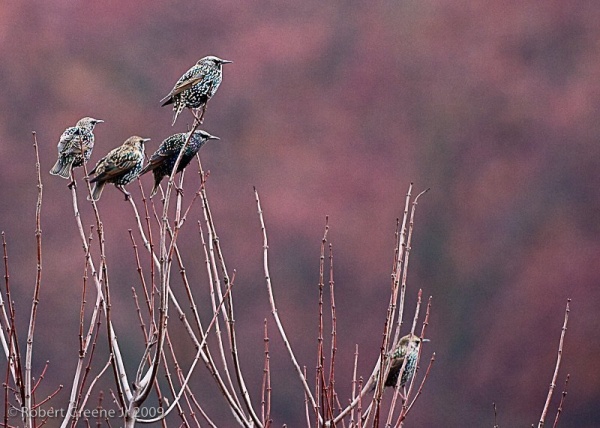When I was in grade school I hated Story Problems in math class — those word problems without formulas, just a bunch of facts to solve.
But life is full of stories. I overcame my disgust, learned how to turn word problems into formulas, and became a math major. Thus when I wrote about starling flocks last Friday I began to wonder…
How did the starling population increase from 100 birds released in Central Park in 1891 to 200 million (or more) in 2013?
Using information on their breeding habits and survival rate, I did some crude mathematics and came up with an answer. First, the facts:
- Starlings north of the 48th parallel produce only one brood per year, the rest produce two. (To give you an idea of this location, the western U.S.-Canada border is at the 49th parallel.)
- Female starlings typically lay 5 eggs per nest.
- 50% – 80% of the eggs survive to the fledgling stage.
- 20% of the fledglings survive to adulthood.
- 60% of the adults survive each year.
(Warning! If math makes your head spin, now’s the time to skip to the end.)
If we started with 100 starlings in Pittsburgh this spring, how many starlings would we have next spring? To make it simple I made some big assumptions and did a lot of rounding.
- 100 starlings = 50 nesting pairs
- 50 pairs * 2 nests per year * 5 eggs per nest = 500 eggs this year
- 50% to 80% of the eggs will fledge. I used 65% * 500 eggs = 325 juvenile starlings in August. I rounded this down to 300.
- 100 adults + 300 juveniles = 400 starlings in August. This is why we see so many starlings in the fall — and this doesn’t even include the migrants.
- 60% of the adults survive to the next spring = 60% * 100 = 60 adults in March
- 20% of the juvies survive the winter = 20% * 300 = 60 former juveniles in March
- 60 adults + 60 of last year’s juveniles = 120 starlings in March
If I’m right (but I’m not) our starling population increases 400% in August, then winter trims it to an annual increase of 20% by March.
But 20% is too high. Sixteen pairs survived from the 100 birds released in Central Park in 1891. If their increase had been uniform it would resemble compound interest over 120 years (1891 to 2011) of about 14%.
(If you skipped the math, resume reading here.)
Interestingly, scientists estimated that the starling population boom in the western U.S. in the 1970’s was 16% per year, so I got close.
Fortunately the starling population seems to have stabilized so their annual increase is now — perhaps — zero.
How’s that for a story problem?
(photo by Bobby Greene)

So fascinating Kate! Thanks for spending some time on the much maligned Starling. I work at a business along the Parkway West, and gaze out the window most days, yearning to be out in the natural world again. The Starlings are always there, and often they perch very close in a nearby tree, not aware of my watchful eye. It never gets old to see and hear a male babbling away, clicking, whistling and generally garbling his heart out. I read somewhere once that they have the largest range of vocal sound combinations of any bird.
I was watching one once when an ambulance siren began wailing down the parkway. The bird stopped mid-warble, and seemed to listen. It then recreated the sound remarkably well. It really made me smile!
Mimicking an ambulance. Way cool, Carolyn!
I think my head just exploded. This reminds me why I was a music major and NOT a math major